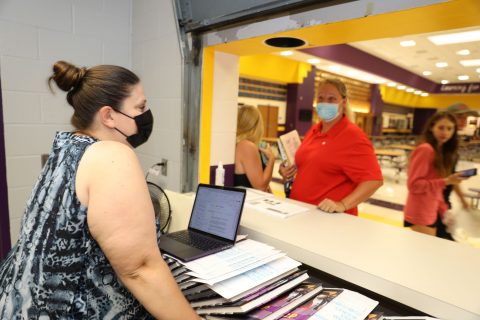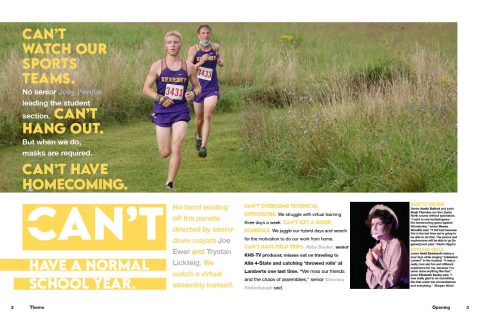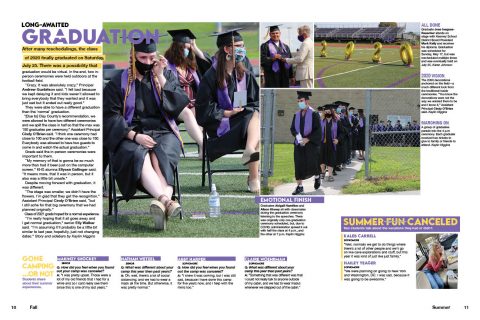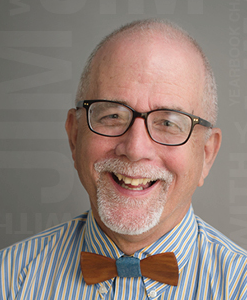Karen Johnson, MJE, always knew she wanted to be a teacher and a coach. When she started college, she realized that social studies (which often seems to go hand-in-hand with coaching) wasn’t really for her. It wasn’t long before she switched to English, then added a journalism minor. Since then, she’s been a yearbook adviser at tiny schools and at large schools. She’s working on her sixth book at Kearney High School, and has helped build a strong program at the school.
You can hear her interview with Jim Jordan on the Yearbook Chat with Jim podcast.
Profile
Karen Johnson
Kearney High School, Kearney, Missouri
High school attended? Kirksville High School, Kirksville, Missouri (9th grade); Lawson High School, Lawson, Missouri (10th-12th grades)
 College attended? Central Missouri State University, Warrensburg, Missouri.
College attended? Central Missouri State University, Warrensburg, Missouri.
They renamed it University of Central Missouri between when I earned my bachelors and my masters and ed. specialist, so I also attended the University of Central Missouri. =)
Did you participate in journalism in high school? I did not participate in journalism in high school. In my early high school years, I really thought I wanted to go into sports medicine as an athletic trainer or physical therapist, but then I got into my biology and anatomy classes and didn’t really love them. I definitely tracked in the college-bound group, pursuing my high GPA and taking college credit classes. Those classes were good challenges and helped me, but I try to keep in mind what I missed out on when I advise my own children about what classes to take.

Did you participate in journalism in college? I did participate in journalism in college. I started as a sports reporter for our college newspaper,The Muleskinner. From there, I served as sports editor and then news editor.
Were you ever a professional journalist? I worked part-time for the Sedalia Democrat as a sports reporter for a few months during college.
Size of your book: 9
Number of pages in your book in 2021: 224
InDesign
Delivery: Summer/Fall – We receive our books in late July and distribute them in early- to mid-August during our registration/schedule pickup days.
Student Population: Approximately 880
Number sold in 2021: 525
Number of books you have advised at Kearney including the 2022? The 2022 book will be my sixth at Kearney.
Other schools you have taught and/or advised at? What years? Awards at previous school?
Pattonsburg Junior/Senior High School, 2003-04; Lee’s Summit North High School, 2004-05; Lawson High School, 2005-2012; Liberty High School, 2012-16
Other classes you teach at Kearney:
Video Media, Intro to Media, Digital Media Internship: Journalism Emphasis, Digital Scholastic Journalism, Broadcast Journalism, Sports Broadcasting, Advanced Publications/Broadcasting
Q&A
How and why did you decide to go into teaching?
When I was thinking way back in high school about my future career, I couldn’t imagine myself anywhere else other than in a school. I’ve always loved school and learning. I had some great teacher examples in my life, and I really admired them. I wasn’t sure I could live up to them, but I wanted to try.
 How and why did you first get involved with scholastic journalism?
How and why did you first get involved with scholastic journalism?
I knew I wanted to be a teacher and a coach (basketball was my life), but I had no idea what I wanted to teach. I’m one of those people who is decent at everything but not a master of anything. I truly think I could have taught anything, except for math, which is really funny because my mom was a math teacher until I was born and my dad was a banker. I thought about teaching business. I thought about social studies, but I didn’t want to be the cliche coach and social studies teacher. In fact, when I first declared my major it was Secondary Education-Social Studies. I’d already decided to change it to English by the time I started my first semester. Once I decided on English, my analytical brain then went to thinking about what I could choose as a minor that would make me most attractive to schools. I decided on journalism. It seemed to pair nicely with English, but it also gave me more options. I’d never taken a journalism class in my life. Little did I know that it would become my only classroom and really my passion. I taught English for 13 years and for 11 or 12 of those years, I taught a variety of journalism classes alongside it.
The funny thing about all of this is that I coached basketball for one year and decided it took too much time away from my family. I do feel that my role as an adviser is to coach and better pairs with my classroom teaching.
 What were the circumstances around you becoming an adviser at Kearney?
What were the circumstances around you becoming an adviser at Kearney?
When I came to Kearney, it was for two reasons: to be in the same district as my children and to be able to move to teaching all-journalism. In many ways, it didn’t make sense to other people for me to make the change from Liberty to Kearney, it was a smaller school, less pay, etc. But those two things made the choice easy for me. I love teaching English, but I don’t miss grading essays and I can focus all my energy on our yearbook and broadcasting programs.
What was the most difficult part of your first year advising?
The most difficult part of my first year advising was that I was definitely on an island. No one else in the school did my job. There was no one to collaborate with, and I didn’t even know I would be teaching yearbook or be in charge of the newsletter when I took the job. I was at a small school, teaching 7th-12th grade English and yearbook.
Oh, and I got married in the middle of that December. It was a very, very hectic and work-filled year. I just kept telling myself it would get better in future years. I just needed to make it through that year. I reached out to my cooperating teachers from student teaching A LOT that year. I cried and I didn’t get much sleep.
 What made you want to come back for year two?
What made you want to come back for year two?
I was actually really lucky, because there was an English opening at the school where I student taught, and I was able to return to Lee’s Summit North for my second year of teaching. That came with the sacrifice of not having any journalism classes that year, which I missed. But it was a large school so I had two preps instead of six or seven, a lot of support, and just more time to get my feet under me as a teacher.
What advice would you give to a first-year adviser?
My advice to a first-year adviser would be don’t try to do it alone. Many advisers are the only or one of the few advisers in their districts. We understand what it’s like. Almost all the journalism advisers I’ve met in my 19 years of teaching have been more than happy to share and help.
What were some of the factors that have led to your success as an adviser over the years?
One of the top reasons for my success as an adviser over the years is surrounding myself with great adviser colleagues. When I have a situation, a question, or just an idea I’m considering, I have some amazing colleagues-turned-close-friends who are always happy to listen and help.
Another success factor is my students. I always try to keep their learning and their goals as my focus. Sometimes it’s easy to start thinking I’ve done this for almost 20 years, I know what I’m talking about and force that on the kids. I have to remind myself that they haven’t done this for 20 years and that they actually learn more if they experience it for themselves versus me just telling them what to do. That doesn’t mean I set them up for failure. I actually talk or coach them through a lot of scenarios and play the devil’s advocate role. With that assistance, they usually come to the best conclusions on their own.
I’m constantly learning something new – from my students, from other advisers, and from studying what others do. That is probably my favorite part of the job.
What has been your biggest challenge as an adviser?
Balance is my biggest challenge. This job can take so much time. My focus the last couple of years has been finding the balance between that and the rest of life. My husband runs his own business and we have three girls ages 13, 10 and seven. I think that struggle also makes me more sensitive to students’ time constraints as well.
Maintaining a drive or a passion can also be a challenge. At least I thought it would be the longer I did this job, but the kids always seem to come up with new ideas that rekindle that at the best times.
You asked for one challenge, but I’m on challenge number three now, so…
Another challenge advisers face is that others we work with or for don’t really understand what we do or how much time it takes.
 You advise a Fall Delivery book. Has Kearney always been delivered in the fall?
You advise a Fall Delivery book. Has Kearney always been delivered in the fall?
I had to get some verification on this question, so I reached out to a former adviser who was at Kearney for more than 25 years and retired a couple of years before I took over the position. He said not only was it a fall delivery during his time but before that as well.
Why have you chosen this delivery timeline?
I don’t like the answer that’s the way we’ve always done it, but in this case that would be pretty accurate. We have considered spring delivery, but several reasons have stopped us over the last five years.
How do you handle distribution?
We distribute the book in early- to mid-August at our registration/schedule pick up day.
 Do you think this affects sales either positively or negatively?
Do you think this affects sales either positively or negatively?
I really don’t think it affects our sales at all. Of course, we’ve never tried another way to know anything different. But, our elementary, middle school and junior high books deliver in May, and I think our sales are consistent with theirs.
Would you ever consider moving to an earlier delivery schedule?
Yes, we would and have considered moving to an earlier delivery schedule. A couple of our hang ups at this point are different coverage for spring sports than other seasons, no prom or graduation coverage, and just having enough staff members to ensure we can finish the book by March or April with a supplement.
2021 book
What was your 20-21 school schedule? Did you start online or in person or a hybrid? Were there any changes as the year progressed?
Our school year start was pushed back a couple of weeks, but then we started hybrid. Our schedule was A Day on Monday and Thursday and B Day on Tuesday and Friday. All students were virtual on Wednesday. At the end of March, we returned to full in-person and continued that through the end of the year.
How did Covid-19 directly affect you and your staff?
COVID-19 affected our staff in several ways, but one of the biggest ones was that we only had six students on staff. Some students who planned to be in the class went all virtual, so they switched classes. We didn’t have the recruiting we would normally have, due to going all virtual in the spring. My biggest goal at the beginning of the year was to help the kids see it was possible for us to create this book with six people, build a vision for how it could happen, and then create structures to help them execute it. It was a lot of work for them, but all my underclassmen from that staff are back this year to do another great book with a much bigger staff.
What have been your biggest challenges and how did you solve them?
One of the biggest challenges in creating last year’s book was just the uncertainty. We came back on a hybrid schedule, but we didn’t know how long that would last. Would we end up going back virtual? What events would happen or not happen? We had so many questions, and most of the answers were “we’ll have to wait and see.” That made it very difficult to plan.
Another big challenge is that we’re an InDesign school. Our school went 1:1 last year…with Chromebooks. That doesn’t work well for us. But, this is where our small staff came in handy last year. We purchased a couple more MacBooks and had enough that each staff member essentially had his/her own MacBook all year when they needed to take it home to work. Google File Stream replaced our server and we continued to roll.
The A and B Days also created challenges with interviewing. We still tried to do as many in-person interviews as we could, but we definitely did many more email interviews than we’ve ever done before. However, and I’m guessing other schools experienced this as well, many students don’t check or answer their email. The kids would try to help each other out and interview students for other staff members on their respective in-person days. I also had staff members who would come in on their virtual days, so they could get interviews any hour instead of just being limited to our class period. Those times kind of took the place of many of our “work nights” last year.
What new coverage ideas have you included in the book?
Of course, we covered masks and the election, but I think the biggest change we made was to include lots of data sidebars with our group photos. We were one of the lucky schools that were able to take group photos. We had to do a photo per group on A Day and then again on B Day, but we had group photos. We were so lucky to be able to do that. Along with that we wanted to illustrate that we couldn’t be stopped. These events were still happening and we recorded lots of specific details in our yearbook. This approach gave us some more flexibility in case events were virtual with no photo opportunities. We used a graphic approach with our text instead.
Of what specific spreads are you most proud?
Our opening spreads last year set the tone for our book and clearly communicated our theme verbally and visually, probably the best any of my staffs have ever done. Beyond that it’s hard to pick certain spreads. I’m continually amazed that the staff met the challenge of creating an award-winning 224 page book about a year like no other with only six members on staff while attending hybrid school most of the year. Every single one of them created quality content on all their spreads despite so many challenges.
2022 book
As the 2022 year gets underway what new challenges are you facing?
I thought we might finally get some normal back for these kids, but there’s been glimpses of that and then still many disappointments. There are seniors in my program who have never been able to attend our state J-Day or go to nationals. In fact, all of them just attended their first in-person Elite Weekend a few weeks ago. Those adventures are a big part of what makes our journalism program so much fun and helps to build relationships in our staff. We are definitely still missing those things so much.
Along with Jessica Kendall and Ronna Sparks-Woodward, we coordinated a leadership training a few summers ago for our staffs from our respective schools. It was Jessica’s amazing idea. It had an immediate effect on my staff and how we operate. We haven’t been able to hold one since. On top of that, the lack of time in the classroom over the last several years means my leadership students are not quite as experienced as they would typically be. All these things combined make every step we take a bit more difficult. I’m trying to remind myself that this is still better for the kids than where we were a year and a half ago. They’re still getting to do what they love at school, in-person. In those ways, we are very lucky.
Tell me about something in your life as an adviser that has made you proud. Or something that keeps you going when things get tough and frustrating.
I didn’t get to take students to national journalism conventions when I taught at smaller schools. I saw the value in attending and competing at these events during my time at Liberty High School. When I moved to Kearney, I had to talk my principal into letting me take students. The second year we attended, we skipped awards and went upstairs to get ready and head out for our planned afternoon/evening activities. I really had it in my mind that we wouldn’t win, so I hated for the kids to sit through that and feel beaten down. We also really were running late, so we went to get ready to leave. I listened to the stream of the awards on my phone while getting ready, mostly because I wanted to know what my friends’ schools won. I set my phone down in the hotel room, just kind of listening while getting ready. It was the weirdest moment, because I was sort of listening, sort of not and I was like I think they just said Kearney High School. What?!? At that moment, I got a call from an adviser friend that we’d won a Best of Show and we needed to get back downstairs and pick up our award. I was calling my EIC and telling her to hustle back downstairs. First big award we won and we weren’t even in the room to go up and get the award. Of course that’s the way it worked out.
It made me proud that these students put our medium-sized school on the map and proved to future staffs it IS completely possible for our school to win these awards. They started a legacy and I challenge students to continue building on it each year in their own way.
The same thing happened a couple of years ago when we earned a CSPA Crown Finalist spot. I didn’t even remember to tune in to see the finalists announced even though I’d marked it on my calendar, and then my phone and email blew up with congratulations. I was so shocked. Several of my yearbook students were in my room at that time. It was such an astonishing and amazing moment to share with them the news of their success.
Tell a story that is indicative of your life as an adviser.
When I was in college, I selected Journalism Education as my minor. That was an adventure. I would say almost half the classes for that minor weren’t offered regularly. I had to submit several requests to substitute classes for the degree. One that I couldn’t substitute was Scholastic Journalism, I think was the name of the class. It was finally offered one semester, only in the evening, and I think there were four or five people in the class. The best part of that class was the instructor, Terry Durnell. She was the broadcasting and yearbook adviser at Lee’s Summit North High School, along with teaching this class in the evenings. She is the perfect example of why I would always argue that current teachers are the best teachers of future teachers. I was about a year away from student teaching and wanted to do so at a larger suburban school, because I had always attended small to medium, more rural schools. I wanted to try something else out to really decide where I wanted to spend my career. She gave us assignments to create actual lessons for our future classes. The.perfect.teacher. I asked her if I might possibly be able to student teach with her and split with an English teacher. The funniest part of all that is that she said she had the perfect English teacher, Jennifer Meiries, in mind at her school, if she could talk her into taking on another student teacher. Terry worked her magic, and I landed the perfect student teaching opportunity to split between English and journalism classrooms in a large suburban school district with two of THE best teachers out there. I knew NOTHING about teaching yearbook. My university cut the yearbook right before my freshman year, so I had never worked on a yearbook staff. I had a strong newspaper background, but Terry gave me so many opportunities to teach students about writing and to learn more about yearbook photography and design. I also met John Kelley, our Walsworth rep, who also served in that capacity for LSN way back in the day. Jennifer and Terry gave me such a solid foundation on how to do this job the right way. They were and are some of my biggest supporters and fans. They showed me how important it is to share, support and be there for each other in the teaching profession. I really can never thank them enough.





